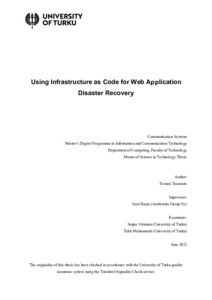Using Infrastructure as Code for Web Application Disaster Recovery
Tuomisto, Tommi (2022-05-31)
Using Infrastructure as Code for Web Application Disaster Recovery
Tuomisto, Tommi
(31.05.2022)
Julkaisu on tekijänoikeussäännösten alainen. Teosta voi lukea ja tulostaa henkilökohtaista käyttöä varten. Käyttö kaupallisiin tarkoituksiin on kielletty.
avoin
Julkaisun pysyvä osoite on:
https://urn.fi/URN:NBN:fi-fe2022060844493
https://urn.fi/URN:NBN:fi-fe2022060844493
Tiivistelmä
Legacy, industry established disaster recovery approaches are known for impeding a relatively high additional expenditure, thus limiting the usage of such mechanisms only to the most business-critical IT systems and applications. However, with the emergence of Infrastructure-as-Code practices, this paradigm can now be challenged.
The objective of this thesis is to design and implement a novel disaster recovery tool, that can be used for the recovery of a web application. By following the design science methodology, this thesis proposes a primary-fallback oriented disaster recovery model, where the fallback site of the infrastructure is an empty cloud service account, into which a near duplicate copy of the primary site is recreated in the event of a disaster.
The proposed recovery process consists of two phases, where the 2nd phase stateful application data recovery procedure is kept as an add-on functionality to the 1st phase stateless infrastructure management practices. For switching from primary to fallback site, the design proposes a DNS failover mechanism, whereby modifying the DNS A-record associations of the Public IP address during the start of the recovery process, traffic can be directed to the recovered site with a minimal delay.
Based on the insights and data gathered during and after the evaluation phase of the proposed design, the tool created with Ansible and Terraform was found to be functional, performant and cost efficient within the known limits and expectations set by legacy disaster recovery practices.
The objective of this thesis is to design and implement a novel disaster recovery tool, that can be used for the recovery of a web application. By following the design science methodology, this thesis proposes a primary-fallback oriented disaster recovery model, where the fallback site of the infrastructure is an empty cloud service account, into which a near duplicate copy of the primary site is recreated in the event of a disaster.
The proposed recovery process consists of two phases, where the 2nd phase stateful application data recovery procedure is kept as an add-on functionality to the 1st phase stateless infrastructure management practices. For switching from primary to fallback site, the design proposes a DNS failover mechanism, whereby modifying the DNS A-record associations of the Public IP address during the start of the recovery process, traffic can be directed to the recovered site with a minimal delay.
Based on the insights and data gathered during and after the evaluation phase of the proposed design, the tool created with Ansible and Terraform was found to be functional, performant and cost efficient within the known limits and expectations set by legacy disaster recovery practices.
